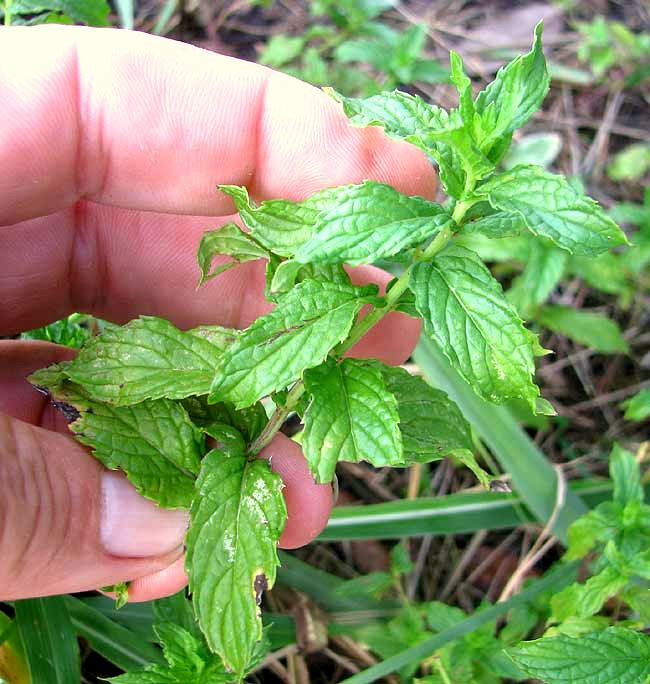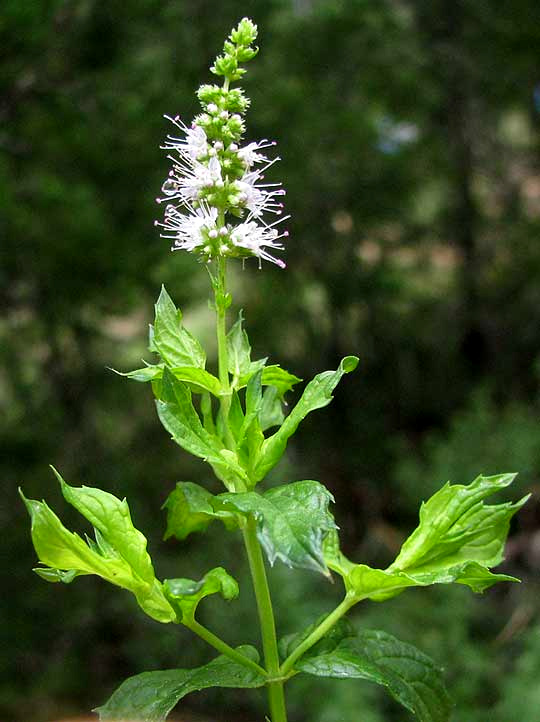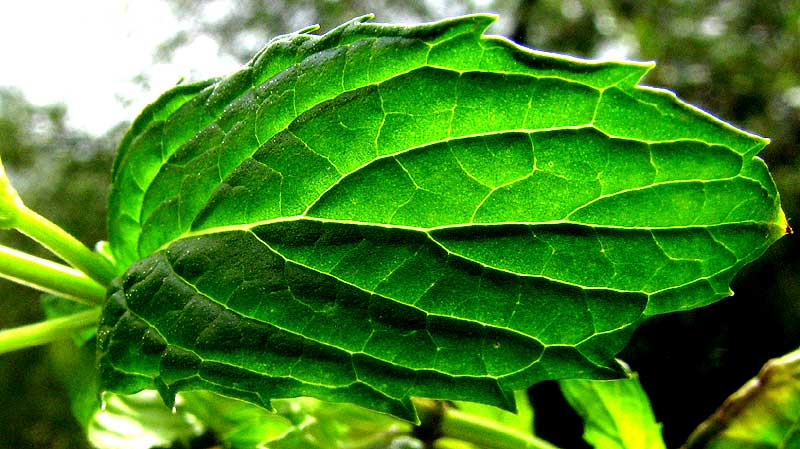Excerpts from Jim Conrad's
Naturalist Newsletter

from the July 21, 2013 Newsletter issued from the Frio Canyon Nature Education Center in the valley of the Dry Frio River in northern Uvalde County, southwestern Texas, on the southern border of the Edwards Plateau; elevation ~1750m (~5750 ft); N29.62°, W99.86°; USA
SPEARMINT
When I arrived in the Dry Frio River Valley last year, behind the red cabin in which I lived there was a leaky faucet next to a tree, beneath which someone thoughtfully had planted mint, so all winter we enjoyed many cups of steamy mint tea. The mint plant was spreading into the grassy lawn despite regularly being mowed down. It was the same kind of mint that during my Yucatan years was grown in prodigious quantities in a kitchen-size, daily-watered bed by Don Filomeno, for use in the resort's kitchen. It's a tough, easy-to-grow, even aggressive mint, one that spreads fast by leafy stolons. It's amazing to have such a pleasingly aromatic herb that can not only defend itself but even grow like a weed when given half a chance. At the top of this page you can see a sprig of the red cabin's faucet mint..
Calling something a mint isn't being very exact. In doing so, are we referring to any member of the big Mint Family, the Lamiaceae, which embraces about 3500 species in 220 genera. Many Mint Family members don't smell minty or look much like the herb in our picture. There's a "mint genus," Mentha, to which belong such classic mints as Spearmint and Peppermint, but if we limit our concept of mint to Mentha, that leaves out such famously minty herbs as Catnip, Horse-Mint, Marjoram and Thyme. To be honest, many minty plants are so similar that often I confuse them. For example, during these years of having the kind of mint in our picture as a neighbor, I've never been perfectly certain which mint it was.
That's because mainly a flowering plant's identity is revealed by its flowers and fruits, but all during my years next to Don Filomeno's mint bed in the Yucatan, and for the last year here, the mints haven't flowered. All this time I've been waiting for at least one sprout to produce flowers, so I could identify with certainty which mint it really was.
Last fall, hearing that the lawn mower was preparing for a visit, I dug much of the mint next to the water faucet and transplanted stem segments into pots so I could give mint plants to anyone who wanted them. Now I have several dozen pots growing and I'm looking for takers. Thing is, none of the plants have produced flowers -- except for one in a pot off in the corner that maybe didn't get watered enough. Maybe that plant got stressed and the stress caused the plant to flower. Whatever the case, you can see its much-awaited inflorescence below:

A close-up of one of its 1/8th-inch-long flowers (3mm) is shown below:

Having a flower, now I could "do the botany." Significant field marks include the following: The slender inflorescence arises at a stem tip, not from leaf axils; The flower bears four stamens (some in the Mint Family, like Rosemary and Sage, have only two), and; The corolla is almost but not quite radially symmetrical (most Mint Family members produce conspicuously bilaterally symmetrical flowers). Notice that the flower's top corolla lobe is not only a little wider than the other three lobes, but it bears a shallow notch at its tip (Actually it's two lobes fused along most of their common margin). These features and the plant's herbaceous, non-woody form lead us to the mint genus, Mentha, so now we figure out which species of Mentha it is.
The inflorescence's slender form, the leaves' having practically no petiole, and bearing saw-like teeth along their margins, and the hairless (glabrous) leaves and stems all direct us to: MENTHA SPICATA, the Spearmint.
Seeing the species name "spicata," meaning "spearlike," we realize that the name Spearmint means "the mint that bears spears" because the spears are the slender inflorescences tipping the herb's branches. If the flowers had been in more or less spherical clusters separated from one another along the stem and occurring in leaf axils, our plant might have been Peppermint. Spearmint's "spears" mean something!
Not only does Spearmint tea taste good but it has a long history of being used medicinally against such ailments as indigestion, cramps, flatulence, nausea, vomiting, colic and intestinal worms.
My impression is that many folks who have Spearmint in their gardens see how lustily it grows and lose some of their admiration for the plant, even to the point of mowing it down. That's a shame because this is a spectacular species -- a native of Eurasia -- worth taking care of, and remembering to use from time to time. Just grab a handful of stems and leaves, drop into a pot of boiling water, and drink, with or without sweetener.
Below, see if that picture of a Spearmint leaf glowing in morning sunlight doesn't strike you as emanating some kind of transcendent benevolence just by being itself, right now.
